|
DragonBall Kai had a production and release history far more complicated than it perhaps should have needed or deserved. Our respective "Tidbit" on the matter takes you through the story, but a crash course for the purpose of reviewing it may be necessary.
In early 2009 we learned that in celebration of the 20th anniversary of DragonBall Z, the series would be receiving a "refreshed" treatment to be aired on television. It would be a condensed, newly voice acted (though primarily with the same cast), and newly scored version of the series using the exact same footage from twenty years prior. There are occasional newly-animated scenes, though they are essentially traced on top of the existing footage (either to replace damaged film, to "enhance" the special effects, or for any variety of reasons we have yet to comprehend).
The "refreshed" series began airing on 05 April 2009. Perhaps most controversially, especially coming off of FUNimation's faux-"remastered" DVD season box sets for DragonBall Z, was that the series was broadcast in a cropped 16:9 aspect ratio. Despite being "remastered" and cleaned-up for a high definition broadcast, there is nothing inherent about the term "high definition" that must define it as "widescreen", and with the series originally being a "full-frame" 4:3 aspect ratio, this seemed like a strange take on its production. During this time, our inside source at the Philippines branch of Toei Animation stood by their statements that they were not cropping the series in their area of production, and yet the TV broadcast was clearly widescreen. It was not until the announcement of the home release that we learned the true story behind the aspect ratio. The show was indeed being produced in 4:3, but was being cropped for television broadcast in Japan. The Blu-ray release, however, would contain the original, full-frame, 4:3 aspect ratio! Unfortunately, the DVD release would be the same cropped 16:9 aspect ratio as the TV broadcast, though in standard definition due to the nature of the format.
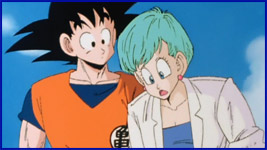 Television Broadcast Version
Television Broadcast Version
|
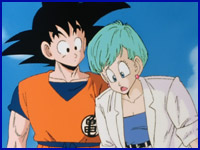 Blu-ray Home Release Version
Blu-ray Home Release Version |
With all of the production questions and answers finally squared away, the home release gives us another opportunity to revisit the so-called "refreshed" version of the series and give it another look over in its "true" quality. The series may be box-set-only for a continued Blu-ray release, but Volume 1 released on 18 September 2009 for ¥3,045 lets us dive right in without a major financial commitment.
The review of this Blu-ray disc was made possible by your referral purchases on CDJapan. If you are interested in contributing to the site, please visit our "Donate" page.

Review By: Mike LaBrie (VegettoEX)
The release style for Kai is an interesting one, and feels much more like an early-2000's North American style than a Japanese one. The first three episodes are easy: there is an individual Blu-ray and an individual DVD, each of which contain the first three episodes of the series. The Blu-ray is high-definition and 4:3, while the DVD is standard-definition and 16:9 (cropped). Easy enough to follow, right? After this first volume, the Blu-ray releases are box-set-only, which contain four individual volumes of three episodes each. The DVD releases, however, are single-disc-only, though they correspond in content to the discs within the Blu-ray boxes.
We have spoken at length about DragonBall Kai on our podcast. With the conclusion of the Saiyan arc, our roundtable discussion basically ended with the same conclusion from all the hosts and guests: it was a neat novelty at first, but it felt very rough, rushed, and just a strange way to celebrate twenty years of DBZ. The vocal performances were all sufficient if not equal to the originals, and even the few cast replacements that were necessary (Hikaru Midorikawa as Tenshinhan) seemed to work out. The music was interesting and overall felt mostly at-home with the series coming from veteran Kenji Yamamoto, but still had some missing element that really secured its place as a true score for the series in the eyes of many fans. In the end, we all simply lost interest in Kai, and rarely keep up with it after this point.
If you are new to the world of DragonBall... well, let's be honest: you're not. Even the most hardcore of non-fans at least have a general idea of what this part of the series is about. Goku's a crazy monkey-boy that goes on adventures, makes friends, defeats enemies, etc. Time passes ("time" being 153 episodes of the original TV series). His evil, alien brother shows up and tells him all sorts of wacky things. He has to team up with his enemy to defeat him, and dies in the process. All caught up are we, now? Great!
The first episode of Kai was the strangest of the bunch, beginning with a "flashback" to Bardock's defeat and the destruction of Planet Vegeta at the hands of Freeza, and then to early events from the original DragonBall TV series for half an episode. Viewers barely had a chance to catch their breath by the time the episode ended, which certainly proved that Kai was not lying about the quickened-pace. The next two episodes slowed it down a little bit, but they still moved along at a pace that essentially knocked the original first five episodes down to three.
The frantic pace of the early episodes makes sense compared to the slowed-down later episodes — there was a change in editors after episode 10, and a new producer after episode 14. Shinichi Fukumitsu had been the editor on nearly all prior anime versions of the series (including many movies), so a shift in this area was somewhat unprecedented. While this staff change does not directly affect the review of these three particular episodes, it does explain how and why things at least feel different even over the course of the same story arc.
It is worth noting that several instances of censoring have occurred throughout the production of Kai. In the early episodes contained on this disc, Goku's penis has been covered, and extraneous blood from the Raditz and Goku death scene has been cleaned up.
At this point, the two general camps of North American feelings on Kai (and there are exceptions, of course) seem to be either continued excitement or complete apathy. With regard to this single disc as an introduction to the show, it is simply not enough material on its own to make an educated and sufficient judgment call on the series as a whole. Sadly, that means either a massive financial commitment in the box-set-only Blu-ray continued release, or a cropped and downscaled individual DVD release.
Being slightly adjusted from the Dragon Box masters of the show, DragonBall Kai basically looks as good as any finely-tuned, weekly-produced animation from 1989 is going to get. Existing footage has been color-corrected in a few areas and upscaled to high-definition when the base, original footage is used. Re-animated scenes (few and far between in the grand scheme of things) are essentially just re-traced scenes on top of the original animation, and run the gamut from sticking out like a sore thumb to blending in perfectly and enhancing the original material. One of the examples most pointed out by fans has been a scene during the "flashback" at the beginning of the first episode — where Goku is swinging from the trees, the outline around his eyes is striking... in a very awkward way:
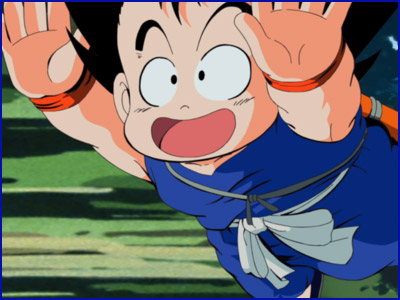
The footage is what it is, though, and any gripes with its production were aired during the show's original broadcast on television. By now it is clear what you are getting in terms of the footage itself, so any real analysis should be done with the packaging and technical details, themselves.
Right off the bat, the biggest change is the 4:3 aspect ratio for the footage. It feels strange to say that, since the footage always was 4:3. In that way, viewing Kai with this framing format simply felt "right". It is a difficult feeling to put into words. Despite all of the changes done to the footage itself, the new voices, the music... at least its raw presentation felt familiar.
Of important note with regard to the aspect ratio is the fact that the opening and ending sequences were actually animated at the the full 4:3. New elements in the animation sequences are finally visible thanks to the extended viewing area, and the two of them look fantastic in high-definition (with the exception of a few minor instances of poor in-between animation frames).
Fans with an uncanny eye of extreme scrutiny will be pleased to know that the misspelling of "paradice" in the on-screen lyrics to the opening theme, first seen in the original airing of the first episode, has been corrected on-disc as it had been with subsequent episodes.
Video encoding seems to be set on automatic, but looks quite nice considering the lack of effort necessary to put into it. No compression artifacts can be seen on the AVC encode hovering close to 40 Mbps.
Chapter breaks are provided at the opening theme, title card, first eyecatch, closing theme, and next episode preview.
The single audio inclusion is a bare-bones stereo track. Everything is crystal clear thanks to the modern voice recording and music production, which can act as a stark contrast to the footage at times. The audio is encoded as stereo 2.0 channel PCM at 1.5 Mbps.
The first Blu-ray volume comes in a standard Blu-ray keepcase which slides within an outside cardboard slipcase. The cardboard slipcase actually contains the most information about the disc, rather than being an extraneous piece of packaging. The front cover (which has a bit of shimmery gloss to it) features a white background with a blue splash of the kanji for Kai, with an image of Goku possibly inspired by a similar pose from the sixth DBZ movie. The back cover is a well-organized listing of the three episodes, which contains the episode titles, original air dates, descriptions, and a corresponding screen shot from each. The cast and staff are listed in the middle area, while the bottom details all of the technical information for the disc.
The keepcase cover is a colorful new image of Goku flying on Kinto-Un alongside Piccolo with Raditz in the background; this image is also used for the standard DVD cover of the first volume. The top also contains an epic bit of text, first used on the "Dragon Box" releases of the DBZ TV series:
|
A journey that began long ago, in a place neither near nor far...
A story of heroes, passed down through the ages...
Until now. This is our story. These are our heroes.
|
A folded flyer for the "Animo" (a portmanteau of "anime" and "mobile", a service for Japanese cell phones) is included as an insert within the keepcase:
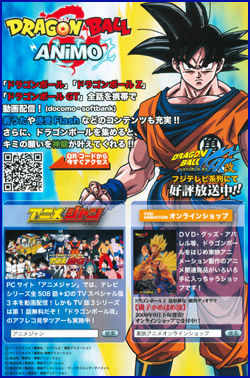
Finally, first-pressing shipments also included a "Dragon Battlers" card of Goku with an HP level of 1700 and a "SPEED" attribute:
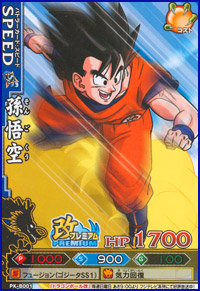
All in all, a pretty standard style of packaging — nothing more, nothing less expected.
The only bonus material with the first Blu-ray volume is an on-disc trailer for DragonBall: Raging Blast. This trailer was one of the first ones that debuted a quick shot of SSJ3 Broli at the very end, which upon the disc's release was already replaced online with a second trailer that contained more footage.
No "clean" versions of the opening and ending are included, and would have been very welcome additions.
Despite being marketed as Blu-ray "Region A" (North America and Japan), it appears that the disc is actually region-free. Our forum member biohazard from Spain had no issue with the disc in their European PS3.
I truly believe that Toei and Happinet began a home release of DragonBall Kai too soon. In order to prevent the home release from catching up to the TV broadcast, they will need to stick with the three-episode-discs on a monthly schedule (with the Blu-ray boxes coming every quarter). Had they waited another couple of months to release the home version, there was the potential to release four-episode-discs on a similar schedule and still remain behind the TV broadcast. This is mostly coming from the North American anime fandom and industry perspective, however, where three/four-episode discs are complete history (in favor of thin-pack box sets). It still seems to fly in Japan, unfortunately.
For those wary about diving into a home release of a series that they technically already own in some capacity, the single-disc Volume 1 actually works quite well. The price point is also a small discount at ¥3045; if broken out from the Blu-ray box sets of four discs, each individual disc would retail for a pretty standard ¥3990. At only three episodes, however, it does little to set itself apart from other series or provide a huge financial incentive for purchase. The individual R2 DVDs for DragonBall Z all contain six episodes each, and even though this is a "new" version of the show at a faster pace, you could still make the argument that each disc contains half the content. The ~$30 price range for a Blu-ray in Japan is actually quite a (comparatively) good deal, though.
How much are you enjoying DragonBall Kai? How familiar are you with the dialogue or Japanese language to watch without subtitles? How long can you wait for any kind of domestic release announcement? These are all questions only you can answer for and about yourself, and will heavily contribute to your purchase decision. The single-disc Volume 1 is a neat way to get in at the beginning for a taste, but a cheaper domestic release (presumably with more episodes per disc) really feels like the ideal format for something like this. Unfortunately, that seems to still be a ways off. How patient are you...?
DragonBall Kai is produced by Toei Animation and released to DVD and Blu-ray by Happinet. Volume 1 Blu-ray: MSRP ¥3045, released 18 September 2009, contains three episodes. Entire disc viewed. Special thanks to Marc for the screencaps.
CDJapan is the preferred vendor for Japanese music here at Daizenshuu EX. The following links take advantage of their affiliate program, and if you purchase an item through these links, it helps us out in bringing you all this great information. We would not plug CDJapan if we did not honestly use them on a regular basis for years and years, and we have never had a single bad experience with them.
DragonBall Kai (Blu-ray) Volume 1 is available at the following online retailers:
|